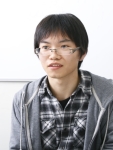What's new
Recruiting!

This laboratory is seeking graduate students (master's and doctoral). Current majors are not required. The research field of biomedical imaging is interdisciplinary and we welcome students from a wide range of disciplines.
A Virtual Tour at NAIST!
Daily Campus Tour
Lab Experience
are conducted!
Message from graduates!

Imaging-based Computational Biomedicine (ICB) Lab.
Yuto Masaki
【Why did you choose ICB lab】
I have always been interested in the fields of bioinformation processing and medical engineering, and I wanted to challenge doing research in a new field when I entered graduate school.
This is how I came to know about ICB lab.
This laboratory was established in the year I entered the university, so I thought it would be interesting to be involved in the start-up of the laboratory.
【What are the strong points of this lab?】
First, I can do research with members from different departments and majors.
Unlike other laboratories, I think it is interesting to be able to do research together with students from other universities and doctors from other hospitals, and to be able to have discussions with them.
Secondly, the seniors are very supportive.
I started my research with no knowledge of medical image processing, but my seniors taught me the basics well, and I was able to start my research right away because of the image processing tools that they have developed over the course of my research.
I was able to quickly acquire the skills necessary for my research thanks to assignments that made good use of these research tools.
The professors are also enthusiastic and supportive of my research. As a result, I was able to give an oral presentation at an international conference in Barcelona.
【What do you enjoy the most being a lab member?】
First of all, I have access to a variety of elemental technologies other than image processing. I am currently conducting research on diagnostic support for liver diseases.
This research uses not only image processing but also machine learning techniques, and I find it interesting to combine these techniques to achieve the objectives.
In addition, since the theme of my research is to improve the quality of medical care, I believe that my current research will be meaningful if it leads to a reduction in the burden on patients in the future, which motivates me.
It was also a good experience for me to observe imaging equipment and surgeries in a large hospital. I also experienced MRI imaging as part of my research.
In terms of daily life, I enjoy my research life by participating in events such as relay races and going out for meals in cooperation with other laboratories.



